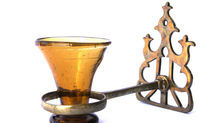The Filigree Technique
- Shira
- May 30, 2019
- 1 min read
In the next few blogs I would like to introduce a number of techniques used in the creation and ornamentation of the beautiful and unique items in our collection. I chose to start with a technique that truly leaves one awestruck when witnessing the fine and delicate detail and craftsmanship involved.
In an earlier blog, The Zadok Workshop, I've mentioned the filigree technique, which is identified, more than any other technique, with Yemenite jewelry. In this remarkable technique, round or flat metal wires of varying thickness are worked on a skeletal structure to create a lacework effect. The decorative effect is sometimes further enhanced by other means as granulating the wires or placing a gem stone at the center of the design.
The craft of filigree, which had been practiced in ancient times, became popular from the medieval period onward. From the 17th century on, we witness a great body of Jewish ceremonial objects of all kinds worked in filigree - Torah crowns, Rimonim, Mezuzot, Spice containers and more. The tradition of filigree work was continued into the 20th century by the craftsmen of the Bezalel School of Jerusalem.





































